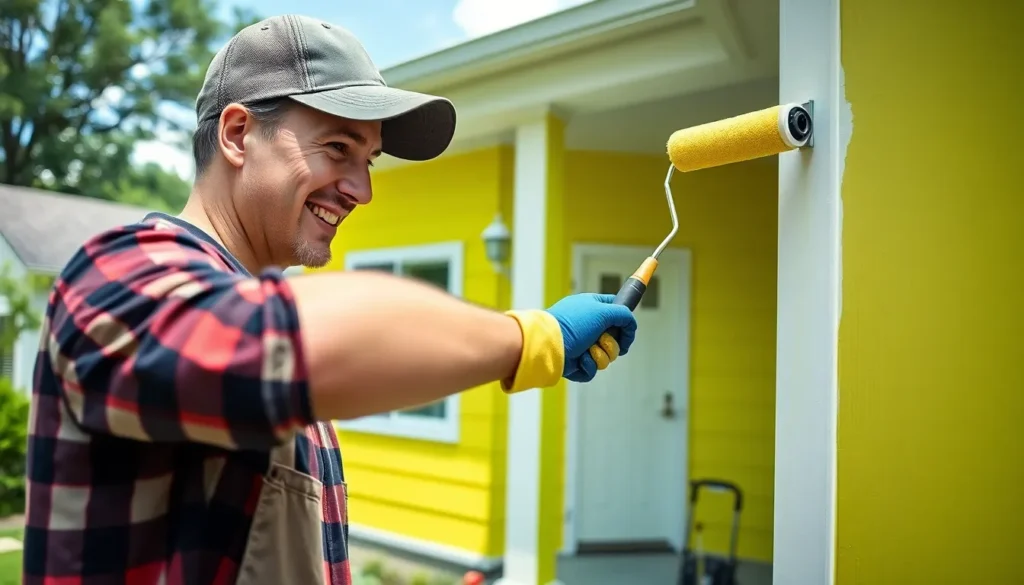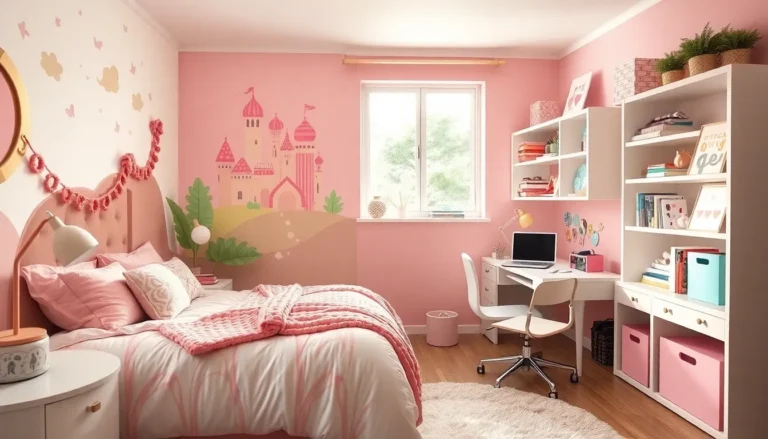When it comes to making a statement, the exterior of a house is like the cover of a book—first impressions matter. A fresh coat of paint can transform a tired facade into a stunning masterpiece that’ll have neighbors doing double-takes. Whether it’s a bold pop of color or a subtle, sophisticated hue, exterior house painting is the secret weapon in any homeowner’s arsenal.
But let’s face it: choosing the right color is tougher than picking a favorite child. And then there’s the actual painting part—unless someone’s got a hidden talent for wielding a paintbrush, it can feel like a daunting task. Fear not! With the right tips and tricks, anyone can tackle this DIY adventure. So roll up those sleeves and get ready to unleash creativity, because a little paint can go a long way in boosting curb appeal and increasing property value.
Table of Contents
ToggleOverview of Exterior House Painting
Exterior house painting significantly affects a home’s overall appeal and may increase property value. A well-executed paint job can provide a fresh, inviting look, enhancing visual interest. Choosing the right color and paint type is crucial for achieving a desirable outcome.
Factors such as climate, architectural style, and local trends influence color selection. What works well in one area may not have the same appeal in another. For instance, warm earthy tones often suit homes in rural settings, while vibrant hues may be more fitting for coastal properties.
When considering paint options, durability plays a key role. High-quality exterior paints resist fading, peeling, and cracking, ensuring longevity. A professional-grade paint can last up to 10 years, depending on weather and surface conditions. Sealants and primers serve as important preparatory steps that enhance adherence and create a smooth finish.
Preparation significantly impacts the final look. Cleaning surfaces, repairing damages, and priming are essential steps before applying paint. Some homeowners opt for pressure washing to remove dirt and grime, while others may scrape and sand surfaces for optimal adhesion.
Timing factors into the painting process. Weather conditions can affect drying times and application quality, making spring and early fall ideal seasons. Ensuring dry weather while painting prevents moisture-related issues, such as efflorescence or peeling.
Ultimately, investing time and effort in exterior house painting pays off through increased curb appeal and improved overall aesthetics. With careful planning and diligent execution, anyone can transform their home’s exterior into a standout feature in the neighborhood.
Importance of Exterior House Painting

Exterior house painting plays a vital role in enhancing a home’s visual appeal and maintaining its value. A well-executed paint job reflects pride in ownership and can set a property apart in the neighborhood.
Curb Appeal
Curb appeal significantly affects a home’s first impression. It can attract potential buyers and positively influence property value. Fresh paint rejuvenates surfaces, making colors more vibrant and surfaces more appealing. Choosing colors that harmonize with the local environment can elevate a home’s attractiveness. For instance, soft pastels work well in suburban areas, whereas bold colors suit urban settings. A thoughtful color scheme ensures the home stands out, encouraging compliments from neighbors.
Protection from Elements
The exterior paint serves as a protective barrier against harsh weather conditions. Quality paint prevents moisture intrusion, which can lead to mold and structural damage. It shields surfaces from UV rays, reducing fading and deterioration. Durable paints resist chipping and peeling, ensuring long-lasting protection. Some options contain mildew-resistant properties, further extending a home’s lifespan. Regular maintenance and repainting can effectively prevent these issues, ensuring a home remains safe and visually appealing for years.
Choosing the Right Paint
Selecting the right paint is essential for a successful exterior house painting project. Various factors influence this decision, including type of finish and color choice.
Types of Paint Finishes
Three primary types of paint finishes are suitable for exterior use: flat, satin, and gloss. Flat finishes are ideal for hiding surface imperfections but lack durability. Satin finishes provide a slight sheen, combining ease of cleaning with moderate durability, making them popular for most homes. Gloss finishes offer the highest durability and are great for trim or accents, though they may highlight surface flaws. Evaluating these finishes based on durability and appearance is crucial for achieving the desired look and maintenance level.
Color Selection Tips
Choosing a color requires consideration of various elements. First, local neighborhood trends and architectural styles should guide selections. Second, colors must harmonize with the surroundings, enhancing the home’s integration within the landscape. Warm or earthy tones suit rural settings, while vibrant hues often complement coastal areas. Testing paint samples in different lighting conditions helps visualize the final result. Matching the colors with existing features, such as roofs and landscaping, also boosts overall appeal. Prioritizing these tips enhances the outcome of the painting project.
Preparing for the Job
Preparation significantly impacts the outcome of exterior house painting. Taking necessary steps ensures a smooth process and lasting results.
Surface Cleaning Techniques
Effective surface cleaning scores high on the list of preparatory tasks. Start by using a power washer to eliminate dirt, mildew, and loose paint. A solution of water and mild detergent can help with stubborn stains. For areas with heavy mildew, a mixture of water and bleach works well to kill spores. Allow surfaces to dry completely before proceeding with further preparations.
Repairing Damages
Repairing damages takes priority before painting. Inspect the exterior for cracks, holes, or peeling paint. Patch small holes with a suitable filler, allowing it to dry before sanding it smooth. Replace or repair damaged siding for a seamless finish. Scraping away loose paint enhances adhesion and creates a uniform surface for the new coat. Addressing these issues fosters better results and extends the life of the new paint job.
Application Process
The application process for exterior house painting involves careful preparation and execution. Homeowners should gather essential tools and materials before starting.
Tools and Equipment Needed
Tools and equipment play a critical role in achieving a professional finish. Essential items include a power washer for surface cleaning, paint rollers and brushes for application, and drop cloths for protecting landscaping. Additional necessities encompass painter’s tape for clean edges and paint trays for easy access. A sturdy ladder allows reach for higher areas, while quality exterior paint ensures durability and a vibrant look. Protective gear, such as masks and gloves, helps safeguard against fumes and skin irritation.
Step-by-Step Painting Guide
A systematic approach simplifies the painting process significantly. First, homeowners should clean the surfaces thoroughly for optimal paint adhesion. Next, patch any damages, such as cracks, to create a smooth foundation. Priming surfaces is the third step, enhancing paint longevity. Once prepped, applying paint starts from the top down, ensuring even coverage. Using a brush for corners and edges leads to a cleaner finish. Finally, allowing adequate drying time between coats guarantees a flawless outcome. Timing each step carefully contributes to overall success and longevity of the exterior paint job.
Maintenance and Longevity
Maintaining exterior paint contributes significantly to a home’s durability and aesthetic. Regular inspections play a vital role in identifying issues before they escalate.
Regular Inspections
Conducting regular inspections enables homeowners to catch paint deterioration early. Examining painted surfaces for cracks or discoloration helps identify areas that may need attention. Checking for signs of mildew or mold ensures the surroundings remain healthy. Scheduling these inspections at least every six months keeps potential issues manageable. Many home inspectors recommend looking for bubbling, peeling, or chipping paint as signs of wear. Addressing these issues promptly protects the home’s structure and appearance.
Touch-Up Tips
Completing touch-ups enhances both the aesthetics and longevity of the paint. Matching the original paint color precisely ensures a seamless appearance. Using a small brush allows for more precise application in hard-to-reach areas. Many professionals suggest applying touch-up paint on cloudy days to prevent rapid drying. Cleaning the area before application removes dirt and contaminants, promoting better adhesion. Regular touch-ups prevent larger areas from needing repainting, saving time and money in the long run. Homeowners should maintain a small reserve of original paint for future touch-ups.
Investing in exterior house painting can significantly elevate a home’s charm and market value. By carefully selecting colors and finishes that complement the architecture and surroundings, homeowners can create a lasting impression.
Proper preparation and execution are essential for a successful paint job that stands the test of time. Regular maintenance and timely touch-ups ensure the exterior remains vibrant and protected against the elements.
With the right approach and a little effort, anyone can transform their home into a visually appealing masterpiece that not only attracts attention but also enhances its overall worth.



